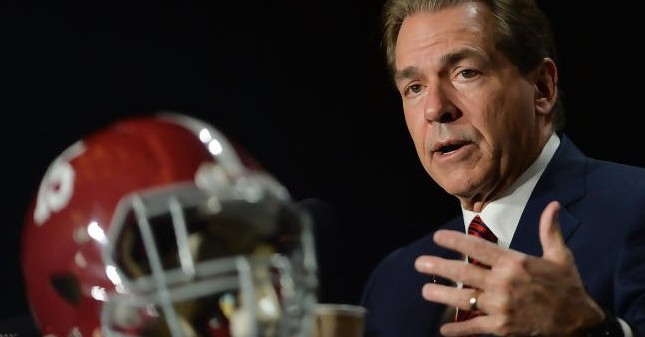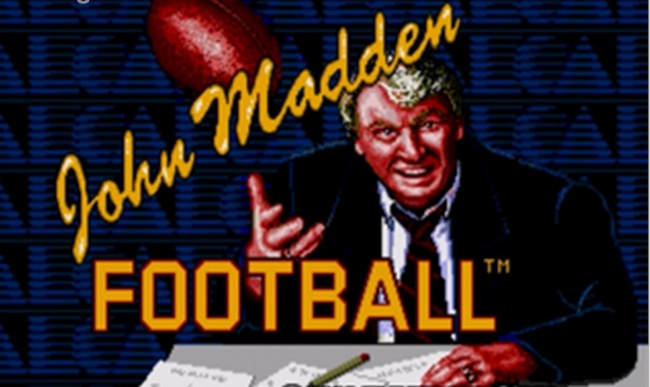College football and the NFL are essentially the same game, but significant differences exist between the two. Both sports are also constantly tweaking the rules in an effort to improve the game, so even hardcore fans can have trouble staying apprised of the rules.
That’s why GuysGirl created this helpful guide spelling out the major rule differences between the college and pro game…
The Playing Field
The field dimensions are the same–100 yards long by 53 1/3 yards wide–but the placement of the hash-marks–those white dashes in the middle of the field–are different.
On an NFL field, the hashes are much closer together; they are aligned with the uprights of the goal post. The college game sets them much wider apart. This may not seem like a big deal, but it actually does affect the game.
After each play, the ball is spotted on one of the hashes or in the middle of the field, depending on where the previous play ended.
For example, if a ball-carrier is pushed out-of-bounds on the right sideline, then the ball will be spotted on the corresponding hash-mark on the right side of the field.
For a college team, that means they have a very wide expanse of field to use on one side and a rather narrow area in which to operate on the other. It also has a huge impact on field goals since the wider hash produces much greater angles for the kickers to deal with than those faced by NFL kickers.
Goalposts
Speaking of kickers and goalposts, the college game uses wider goalposts than the NFL. NCAA goalposts are 23′ 4″ apart compared to 18′ 4″ in the NFL. The wider goalposts in college help offset the greater angles caused by the wider hash-marks.
How Players are Ruled Down
Perhaps the most glaring difference between the college and pro games is how players are ruled “down”.
In the NFL, a player is down when he is either on the ground and touched by an opposing player or goes to the ground as a result of contact with an opposing player.
In college, a player is down whenever a part of his body other than his feet or hands touches the ground, regardless of whether or not he was touched by an opposing player.
What that means is that if an NFL player falls to the ground without being touched–say after making a diving catch or losing his footing—he can get back up and keep running because the play is still live. In college, he’d be down.
There are some exceptions: in college, the holder on a field goal try is not considered down when he receives the snap even though his knee is on the ground; in the NFL, a quarterback is considered down when he kneels after taking a snap in order to run out the clock.
Also, a kick returner can kneel in the end zone for a touchback and cause the play to be blown dead.
Number of Feet Inbounds for a Catch
Another big difference between the two versions is the number of feet required to be in-bounds for a receiver to make a legal catch.
In the NFL, a receiver must get both feet down in-bounds with control of the ball for it to be considered a catch. The college game only requires one foot.
Pass Interference
Speaking of receivers, the college game differs from the NFL in the penalty it assesses for pass interference.
In the NFL, pass interference is a spot foul; the ball is spotted where the interference occurred. In college, however, it is a 15-yard penalty.
For instance, let’s say the offense has the ball at its own 30-yard line, and the quarterback throws the ball deep. The defender commits pass interference at his own 20-yard line.
In the NFL, the ball is placed at the 20, resulting in a 50-yard gain for the offense.
Under the NCAA rules, the ball would be placed at the offense’s 45, a gain of only 15 yards.
Clock Rules
Both the NCAA and NFL use different clock rules. The NCAA stops the clock whenever a first down is achieved so that the chains can be reset. Once they are in place, the clock resumes. In the pro game, the clock keeps running.
That has huge implications at the end of games when time is short.
A college team can afford to throw the ball over the middle of the field because the clock will briefly stop.
A pro team doesn’t have that luxury because the clock keeps running.
On the flip side, the NFL does have the two-minute warning whereas college football does not. The two-minute warning is, well, a warning that there are only two minutes left in the half. In essence, it’s a free timeout for both teams. The clock is stopped.
Two-Point Conversion
The NFL and NCAA both give their teams the option of going for two after scoring a touchdown, but the former places the ball at the two-yard line while the latter spots it at the three.
Overtime
In the NFL, all regular season games that are tied at the end of regulation are decided by a modified sudden-death overtime period.
Basically, they play another quarter, and the first team to score wins, with one caveat: both teams get a possession unless the team receiving the opening kickoff (there’s a coin toss before the start of the overtime period to decide who receives) scores a touchdown on its opening drive.
If they kick a field goal, the other team still gets a possession. If the receiving team doesn’t score, or kicks a field goal but the other team matches it, the game reverts back to the regular sudden-death format where the first team to score wins.
College football uses a much different format.
Like the NFL, it starts with a coin toss, but instead of determining who is kicking, the winner decides whether to play offense or defense first.
See, college football’s overtime isn’t sudden-death. It’s more like baseball innings. There is no clock—although the play clock still runs—and each team gets the ball.
The way it works is that one team starts with the ball on the 25-yard line and tries to score. Normal rules apply (first downs, penalties, etc.). Once they are done, the roles are reversed, and the other team gets a crack at playing offense. If the score is tied after both teams have the ball, the game continues into a second overtime. If the game is still tied after two overtimes, then the teams will be forced to attempt two-point conversions any time they score a touchdown.
Instant Replay
The NFL uses a challenge system where each coach has to throw a flag onto the field to challenge a play. There are limitations to what plays can be challenged; for instance, a coach can’t challenge a pass interference play. Each coach gets two challenges per game, and if they get them both right, they get a third.
Each challenge costs a timeout, but if the challenge is correct, that team gets the timeout back. Coaches cannot challenge calls within the last two minutes of a half as replay reviews are decided by replay officials in a booth.
Also, all scoring plays are automatically reviewed, and starting this year, all turnovers will be reviewed as well.
College football doesn’t have a standardized replay system in place. That is left up to the individual conferences. For non-conference games, the home team’s conference rules are used.
Regular Season
The NFL plays a 16-game season over 17 weeks, not including postseason or preseason play.
The NCAA generally plays a 12-game season, unless a team is eligible for the “Hawai’i Exemption”. No, it’s not a Robert Ludlum novel.
The exemption allows a team that has to play at Hawai’i to play an extra game, resulting in a 13-game season instead of a normal 12-game season. The extra game is used to offset the travel costs associated with flying out to our nation’s most remote state.
Under the rule, Hawai’i also gets an extra game because of the travel costs associated with playing all of its away games on the mainland. The rule also applies to schools in Alaska and Puerto Rico, but neither has a Division I football team.
College football also has conference championship games for those conferences of at least 12 teams.
The SEC, for example, is split into the SEC East and SEC West divisions, and the division winners meet in the SEC Championship Game to determine the conference champion and recipient of the conference’s automatic bid to the Sugar Bowl. Not every conference has a championship game, however.
This all means that college football teams won’t finish with the same record.
In 2011, Georgia finished at 10-4 while fellow SEC member South Carolina was 11-2. Both played a 12-game schedule, but Georgia played in the SEC championship game and a bowl game while South Carolina only played in a bowl game. Colorado State went 3-9 while Colorado was 3-10 because the Buffs played at Hawai’i.
Postseason
College football and the NFL use vastly different postseason formats. The 32-team NFL is split up into two conferences, each with four divisions. A 12-team playoff is used, with each conference having 6 playoff spots.
Each division winner receives a playoff berth, and the top two remaining teams in each conference earn wild card spots. The top two overall seeds earn byes in the first round, and the conference champions meet in the Super Bowl.
NCAA Division I football currently has over 120 teams in 11 conferences and uses a convoluted system known as the BCS (Bowl Championship Series) to determine a champion.
The BCS uses a number of human polls and computer rankings to determine the number 1 and 2 teams in the country and matches them up in the BCS National Championship Game.
There are no playoffs, although many conferences are large enough to form two divisions and stage a conference championship game. The system is flawed and controversial because many years there aren’t just two-clear cut top teams.
In 2004, there were four undefeated teams in the country, yet Auburn and Utah weren’t able to play for a national title. Boise State, Hawai’i, and Cincinnati have all been undefeated yet left out of title consideration—the Broncos on multiple occasions.
Most years have resulted in a number of one-loss teams all vying for one of the title game spots, and trying to sort out which team is most-deserving is a painful task that leaves many fans unsatisfied.
Teams that don’t make this game still get to participate in postseason play in the form of bowl games. There will be 34 bowl games in 2012, not counting the title game, of which the four BCS Bowls (Rose, Sugar, Fiesta, and Orange) are the most prestigious.
In order to be bowl-eligible, a team must have at least six wins, and only one of those wins may come against a lower-division team. If a team has beaten two lower-division teams, then they need at least seven wins.
Teams with losing records cannot qualify for a bowl unless they receive an automatic berth. North Texas earned a berth in the 2001 New Orleans Bowl despite a losing record of 5-6 because they were the Sun Belt Conference champions.
Earlier this year, Division I presidents and conference commissioners approved a four-team playoff to decide the national champion starting in the year 2014.
Details are still being worked out, but a selection committee similar to the one used to select the teams for the NCAA basketball tournament will decide which four teams will play.
Featured image via NFL World






